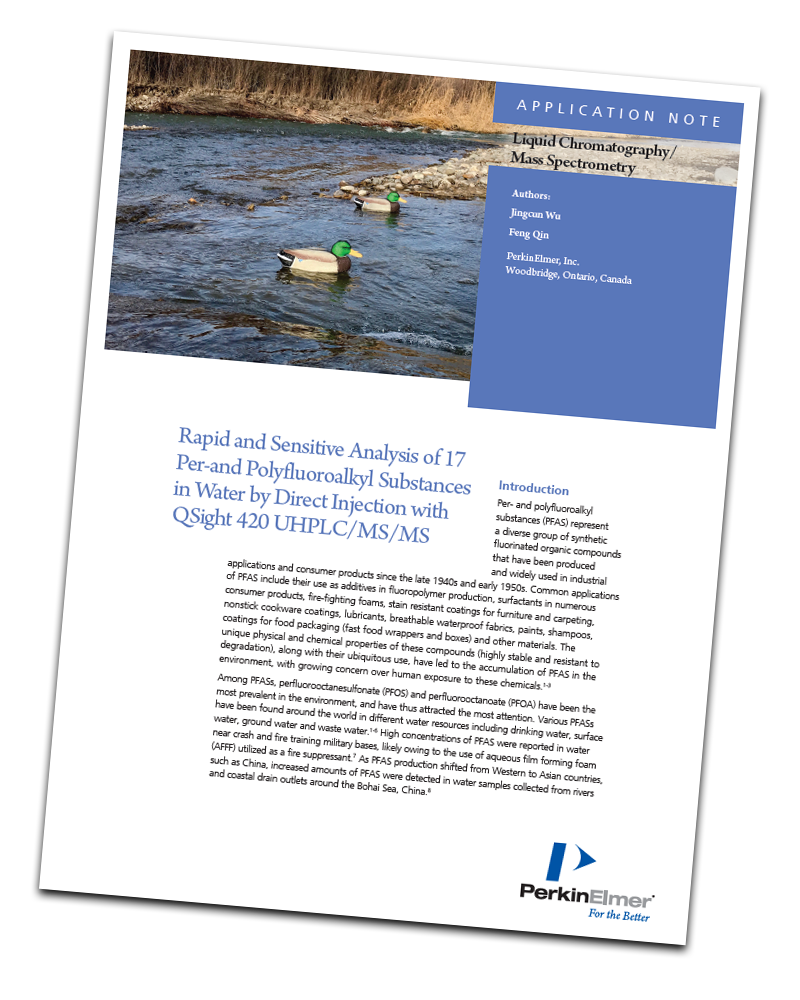This study demonstrates a direct injection approach to PFAS analysis, utilizing a PerkinElmer QSight® 420 mass spectrometer coupled with UHPLC for the analysis of trace amounts of PFAS in drinking water and surface water samples.

Per- and polyfluoroalkyl substances (PFASs), or per- and polyfluorinated compounds (PFCs), represent a group of anthropogenic chemicals that have been produced and widely used in industrial applications and consumer products since the 1950s. The unique physical and chemical characteristics of these compounds (highly stable and resistant to degradation), along with their ubiquitous use, have led to the accumulation of PFAS in the environment, with growing concern of human exposure to these chemicals.
Among PFASs, perfluorooctanesulphonic acid (PFOS) and perfluorooctanoic acid (PFOA) have been the most prevalent in the environment, and have thus attracted the most attention. Exposure to these chemicals in the United States and Europe is mainly from legacy use of PFAS containing products which are persistent in the environment. PFOA and PFOS have been found around the world in different water resources, including drinking, surface, ground and waste water. High concentrations of PFASs were reported in water near crash and fire training military bases. As PFAS production shifted from Western to Asian countries, such as China, increased amounts of PFOS and PFOA were detected in water samples collected from rivers and coastal drain outlets around the Bohai Sea, China.
PFOS and PFOA have been included in many advisory guidelines. For example, the United States Environmental Protection Agency (U.S. EPA) issued a health advisory of 70 parts per trillion (ppt) for PFOA and PFOS in drinking water. The latest European Commission adopted proposal for PFASs are 100 ppt for an individual PFAS compound, and 500 ppt for total exposure to PFASs. The development of an efficient strategy for identification and quantification of PFASs is essential for risk assessment. The most widely used analytical method for PFAS monitoring is LC/MS/MS owing to its high sensitivity, selectivity and robustness. Multiple methods have been developed for the analysis of PFAS in environmental matrices, including:
- United States Environmental Protection Agency
- International Organization for Standardization (ISO)
- The American Society for Testing and Materials (ASTM)
Recently, with the advancement and availability of highly sensitive mass spectrometers, a trend towards developing a high throughput analytical method for the determination of PFAS by direct injection, without SPE, has been appreciated. The direct injection approach can not only aid in achieving the highest sample throughput, save time and reduce cost, but also minimizes potential analyte loss and contamination resulting from SPE sample preparation.
In conclusion, this study demonstrates a simple, rapid, sensitive and cost-effective LC/MS/MS method for the analysis of 17 PFASs in drinking and surface water samples at sub to low ng/L (ppt) levels by coupling a LX50 UHPLC system to a QSight 420 triple quadrupole mass spectrometer. In addition to its high sensitivity, the method showed a wide linear dynamic range and eliminated the SPE sample preparation procedures, and, therefore, not only reduced the cost and saved time for sample analysis, but also prevented potential contamination from SPE sample preparation steps. The method has been applied for real water sample analysis with good accuracy.




